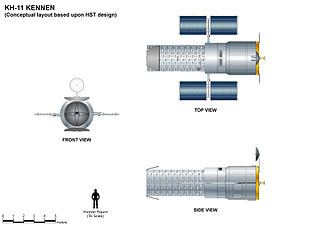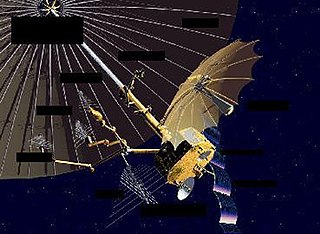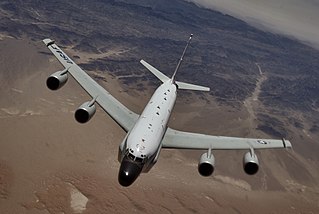Related Research Articles

The National Reconnaissance Office (NRO) is a member of the United States Intelligence Community and an agency of the United States Department of Defense which designs, builds, launches, and operates the reconnaissance satellites of the U.S. federal government. It provides satellite intelligence to several government agencies, particularly signals intelligence (SIGINT) to the National Security Agency (NSA), imagery intelligence (IMINT) to the National Geospatial-Intelligence Agency (NGA), and measurement and signature intelligence (MASINT) to the Defense Intelligence Agency (DIA). The NRO announced in 2023 that it plans within the following decade to quadruple the number of satellites it operates and increase the number of signals and images it delivers by a factor of ten.

The KH-11 KENNEN is a type of reconnaissance satellite first launched by the American National Reconnaissance Office (NRO) in December 1976. Manufactured by Lockheed in Sunnyvale, California, the KH-11 was the first American spy satellite to use electro-optical digital imaging, and so offer real-time optical observations.
Zircon was the codename for a British signals intelligence satellite, designed to intercept radio and other signals from the USSR, Europe and other areas. It was intended to be launched in 1988 on a NASA space shuttle. However, the project was cancelled in 1987 because of its cost. Secrecy about the project's cost, hidden from the British Parliament, resulted in the Zircon affair.
Magnum was a class of SIGINT spy satellites reportedly operated by the National Reconnaissance Office (NRO) for the United States Central Intelligence Agency (CIA). The program remains classified, and the information that exists is speculative.

Aquacade, previously designated Rhyolite, was a class of SIGINT spy satellites operated by the National Reconnaissance Office for the United States Central Intelligence Agency. The National Security Agency (NSA) was also reportedly involved. The program, also known by SIGAD AFP-720 and SIGAD AFP-472, respectively, is still classified. During the same period, the Canyon SIGINT satellites were in use with an apparently somewhat different set of capabilities.
Shoal Bay Receiving Station is a signals intelligence-gathering facility in the Northern Territory of Australia located on the shores of Shoal Bay about 19 kilometres (12 mi) north-east of the Darwin CBD. The site is managed by the Australian Signals Directorate (ASD).

The Naval Ocean Surveillance System (NOSS) is a series of signals-intelligence satellites that have conducted electronic signals intelligence for the U.S. Navy since the early 1970s. The first series of satellites were codenamed "White Cloud" or "PARCAE", while second- and third-generation satellites have used the codenames "Ranger" and "Intruder". According to the Union of Concerned Scientists in 2023, the system may be called the Space-Based Wide Area Surveillance System (SB-WASS).
TRUMPET is reportedly a series of ELINT reconnaissance satellites launched by the United States during the 1990s to replace the Jumpseat satellites. Speculated to weigh 5,200 kg, three of these satellites were launched into highly elliptical (Molniya) orbits by Titan 4 launch vehicles from Cape Canaveral between 1994 and 1997. Their precise mission and capabilities are classified. News reports state that the satellites monitor radio communication using antennas with diameters of 150 m. It is speculated that the satellites are manufactured by Boeing.

Orion, also known as Mentor or Advanced Orion, is a class of United States spy satellites that collect signals intelligence (SIGINT) from space. Operated by the National Reconnaissance Office (NRO) and developed with input from the Central Intelligence Agency (CIA), eight have been launched from Cape Canaveral on Titan IV and Delta IV launch vehicles since 1995.
Signals intelligence by alliances, nations and industries comprises signals intelligence (SIGINT) gathering activities by national and non-national entities; these entities are commonly responsible for communications security (COMSEC) as well.

Signals intelligence operational platforms are employed by nations to collect signals intelligence, which is intelligence-gathering by interception of signals, whether between people or between machines, or mixtures of the two. As sensitive information is often encrypted, signals intelligence often involves the use of cryptanalysis. However, traffic analysis—the study of who is signalling whom and in what quantity—can often produce valuable information, even when the messages themselves cannot be decrypted.

USA-200, also known as NRO Launch 28 or NROL-28, is an American signals intelligence satellite, operated by the National Reconnaissance Office. Launched in 2008, it has been identified as the second satellite in a series known as Improved Trumpet, Advanced Trumpet, or Trumpet follow-on; a replacement for the earlier Trumpet series of satellites.
After the end of World War II, all the Western allies began a rapid drawdown of military forces, including those of signals intelligence. At the time, the US still had a COMINT organization split between the Army and Navy. A 1946 plan listed Russia, China, and a [redacted] country as high-priority targets.

USA 202, previously NRO Launch 26 or NROL-26, is a classified spacecraft which is operated by the United States National Reconnaissance Office. It is an Advanced Orion ELINT satellite. According to Aviation Week, it "fundamentally involves America's biggest, most secret and expensive military spacecraft on board the world's largest rocket." The combined cost of the spacecraft and launch vehicle has been estimated to be over US$2 billion.

USA-207, international COSPAR code 2009-047A, also known as PAN, officially meaning Palladium At Night, NEMESIS I, or P360 is a classified American SIGINT satellite, which was launched in September 2009. The US government has not confirmed which of its intelligence agencies operate the satellite, but leaked documents from the Snowden files point to the NSA. The spacecraft was constructed by Lockheed Martin, and is based on the A2100 satellite bus, using commercial off-the-shelf components. The contract to build PAN was awarded in October 2006, with the satellite initially scheduled to launch 30 months later, in March 2009.

Vortex, previously known as Chalet, was a class of spy satellite operated by the United States during the 1980s and 1990s to collect signals intelligence (SIGINT) from high Earth orbit. The Vortex satellites were operated by the National Reconnaissance Office for the United States Air Force and listened to radio transmissions originating from Earth or space. The intercepted data is believed to have been fed into and analyzed by the National Security Agency ECHELON system.
USA-229, known before launch as NRO Launch 34 (NROL-34), is a pair of American signals intelligence satellites which were launched in 2011. They are operated by the United States National Reconnaissance Office.
USA-184, also known as NRO Launch 22 or NROL-22, is an American signals intelligence satellite, operated by the National Reconnaissance Office. Launched in 2006, it has been identified as the first in a new series of satellites which are replacing the earlier Trumpet spacecraft.
Tongxin Jishu Shiyan is a Chinese military satellite program operating in geostationary orbit (GEO). TJS satellites are manufactured by the Shanghai Academy of Spaceflight Technology (SAST) and launched from Xichang Satellite Launch Center (XSLC) in China's southern Sichuan Province. TJS is likely the cover name for multiple geostationary military satellite programs and should not be confused with the similarly named Shiyan satellite program.
References
- 1 2 3 Pike, John (1997-03-09). "Intruder". Federation of American Scientists . Retrieved 2008-10-28.
- ↑ rob1blackops (2017-07-31). "History of the US high-altitude SIGINT system". SatelliteObservation.net. Retrieved 2024-11-25.
{{cite web}}: CS1 maint: numeric names: authors list (link)